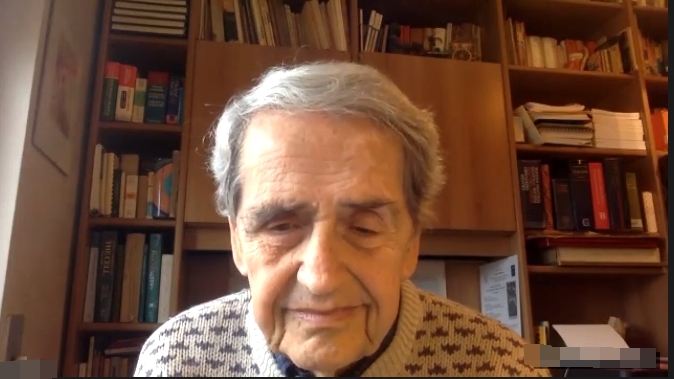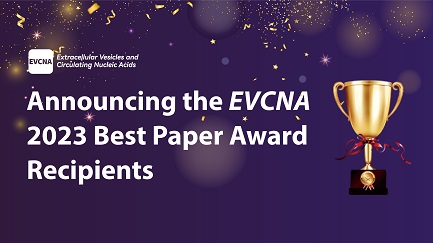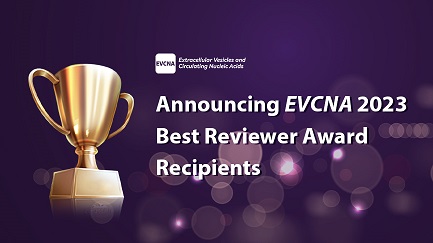An Exclusive Interview with Prof. Dr. Jacopo Meldolesi—A Member of Academia European
On December 1st, 2023, the Editorial Office of Extracellular Vesicles and Circulating Nucleic Acids (EVCNA) conducted an exclusive interview with Prof. Dr. Jacopo Meldolesi, who is a stalwart in extracellular vesicle research. In this interview, we primarily delved into his current endeavors and his influential journey in the realm of extracellular vesicles.
During the interview, Dr. Meldolesi generously shared insights into his research journey concerning extracellular vesicles, highlighting the motivation and inspiration driving his impactful work. Here’s a glimpse into our conversion:

(Picture of the exclusive interview)
Self-statement by Dr. Meldolesi:
I retired from my Institute 13 years ago, where I was has been conducting research. Currently, I am still engaged in academic pursuits and have recently submitted another review. Presently, I have no laboratory, no collaborators, and no grants to support research. So, I am a bit limited from this point of view. However, my prior extensive experience allows me to continue as a scientist, based on the connections established with colleagues and friends over the years. I dedicate most of my time to work, primarily from home, but I am also able to visit my institute and hospital, both top establishments in my country, Italy. Nevertheless, my influence in these institutions is limited now. I was the first to initiate research activities in this institute many years ago, hence my historical significance.
Questions and answers:
Q1: We know that you have engaged in various research studies across different stages of your career. Initially, your focus was on the secretory pathway, cell interactions, and later on the diverse forms of exocytosis and endocytosis and the expression of neurosecretion. Could you please elaborate on how you integrated your previous research experiences with your exploration of extracellular vesicles?
A: This question deeply resonates with my scientific journey, which began in 1970 at Rockefeller University in the laboratory of the distinguished Nobel laureate—Prof. George Palade, who was not only a mentor but also a close friend. He was a luminary in cell research, and my tenure alongside him at Rockefeller University in New York was truly formative. I started off with great enthusiasm. Upon returning to Italy and establishing my laboratory, I continued to build upon my foundational work. A significant shift occurred when I transitioned into neuroscience, a field that aligned well with both my expertise and interest. However, a turning point emerged when a younger colleague noticed a growing trend among our contemporaries focusing on extracellular vesicles. This is an interesting anecdote. The colleague came to me and said, “All your friends have started to work on this. Why do we not compete with this?” At that juncture, this suggestion wasn’t feasible due to his imminent move to the United States. Instead, we agreed to collaborate on an introductory piece on extracellular vesicles, which I penned for the prestigious journal, Trends in Cell Biology. This contribution was remarkably successful, and acknowledged as the leading review on extracellular vesicles. Subsequently, I received requests from other journals to contribute to this topic, and I willingly obliged. However, upon my retirement, I encountered a hurdle—a lack of research grant support. I approached journals with a straightforward query:” I lack funds; therefore, I cannot afford publication costs.” Eventually, I received an invitation from the journal EVCNA, which is engaged in extracellular vesicles with no financial constraints, resulting in my collaboration with them. This collaboration brought me immense pleasure, and my contributions, albeit slightly intricate for the community, proved successful, culminating in widespread recognition and prestigious requests. Consequently, I continue my research journey through reviews focusing on extracellular vesicles.
I retired in 2010, but for about five years, I maintained some collaborations, and funding, allowing me to continue working as before. Later, I continued my research but exclusively collaborated with journals that didn’t require payment for publication. Currently, I have affiliations with five journals that not only publish my work but also engage me as an Editor. Remarkably, at the age of 86, My career endures. I am still immersed in my work similar to what I started at Geroge Palade’s laboratory in Rockefeller when I first arrived in the United States. Upon retiring from the University in Milan, Italy, the administration extended an offer for continued work, especially in teaching roles with additional compensation. However, I chose to conclude my teaching career and instead focus on research and scholarly articles, a commitment I have upheld for over a decade.
Q2: EVs are increasingly recognized for their role in health and disease, yet they present challenges due to their heterogeneous nature and complexity, making their study quite elusive. Could you share your insights on addressing future challenges in EV research?
A: My approach diverges slightly from that of others in the field. I’ve published extensively on the heterogeneity and complexity of extracellular vesicles, shedding light on the fact, that often, different types of these vesicles aren’t distinctly separated. I have made some progress in this area, but there are limitations as most laboratories tend to study these vesicles collectively. Separating them poses significant challenges because four distinct types are produced separately and subsequently amalgamated. This amalgamation remains a limitation. The potential here is profound, yet it is currently explored in a limited capacity. For example, in Milan, my city, the tremendous potential of these vesicles exists. However, this potential remains restricted as different vesicle types aren’t easily segregated. We receive numerous proposals to work with extracellular vesicles, but they often lack separation. Separation isn’t merely about isolating one type of vesicle from others; it involves targeted isolation, which remains a limitation. I’m anticipating advancements in this direction, which, in my opinion, have not been sufficiently explored.
I intend to persist in my work with extracellular vesicles. The future is uncertain for me; perhaps next year, I'll still be engaged. I've already accepted intriguing proposals. Hence, I could be collaborating with a few journals. I'm a member of our country's ancient academy, where I'm already contributing. I might continue my work with the institution and journals. However, I'm uncertain about stopping my work in two or three years. It's a decision that's entirely mine. There's no external pressure guiding me in one direction or another. This aspect largely depends on various countries' policies. For instance, I can cite the case of my first student. Initially, he wished to complete his medical studies, joined my laboratory, and later pursued work in significant laboratories in the United States, where he gained substantial recognition, eventually becoming the president of the American Society for Cell Biology. However, such opportunities aren't as readily available in Italy, where after 70 years, establishing a laboratory and obtaining grants becomes challenging. In contrast, the United States offers more facilitative conditions in this regard.
Q3: Your achievements in this field are highly esteemed. What motivates and sustains your dedication to scientific research at this stage of your career?
A: I maintain connections with my former institute and numerous individuals who are currently pivotal figures there—individuals who began their journey when I served as the director. Since my retirement, new scientists have joined the institute, injecting new power into it. Despite not being a formal member, I continue pursuing my interests. Remaining active in extracellular vesicle research allows me to persevere. This is a personal choice; one I'm committed to because it aligns with my desires. My wife supports my work. While my contributions might not feature prominently in high-profile journals anymore—I used to publish in esteemed journals like Nature, Trends in Cell Biology, and Trends in Pharmacology during my tenure at the institute—my current level might not match those from years ago. However, on occasions, I'm still requested to produce exceptional work, albeit infrequently. Reflecting on my journey, I am grateful for the opportunities to continue contributing to this fascinating field.

Prof. Dr. Jacopo Meldolesi
Dr. Jacopo Meldolesi, a distinguished member of EMBO, Academia Europaea, and Accademia dei Lincei, has made remarkable contributions to scientific research. He notably served as the president of the Italian Society of Neuroscience (SINS) from 1997 to 1999 and the president of the Federation of Italian Biological Societies (FISV) from 2003 to 2007. His accolades include the Camillo Golgi Award (Washington) in 1988, the Feltrinelli Award of the Accademia dei Lincei in 1994, and the Gold Medal of the President of the Italian Republic (Rome) in 1999.
Editor: Sally Sheng
Language Editor: Catherine Yang
Production Editor: Kenny Wu
Respectfully submitted by the Editorial Office of EVCNA












